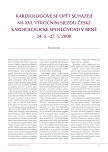-
Medical journals
- Career
New stimuli from the Integrated Biomarkers in Cardiovascular Diseases conference
Authors: M. Dobiášová
Authors‘ workplace: České republiky, Praha ; Fyziologický ústav Akademie věd
Published in: Kardiol Rev Int Med 2008, 10(2): 80-82
Overview
The plasma lipoprotein profile has a crucial effect on the development of atherosclerosis with resulting cardiovascular (CV) diseases. A number of demographic and clinical markers of CV risk such as sex, age, body mass, blood pressure and diabetes mellitus are reflected in a specific plasma lipoprotein profile. Atherogenic profile is characterized by increased concentrations of small dense LDL particles, and/or lack of large HDL particles and/or increased concentrations of large VLDL particles. However, the evaluation of CV risk based on the complex of differently sized lipoprotein populations is difficult in practice. There were proposed biomarkers of lipoprotein quality characterizing subpopulations distribution: Fractional Esterification Rate of cholesterol (FERHDL) and Atherogenic Index of Plasma (AIP): a logarithmically transformed ratio of molar concentrations of triglycerides (TG) to HDL-cholesterol. These two parameters have shown be the best predictors of findings on coronary angiography. AIP as a simple, cost - reasonable biomarker of lipoprotein profile seems to be suitable for a practical use. AIP can differentiate CV risk categories, particularly in mixed dyslipidemia : the lowest risk is represented by values below 0.11, the intermediate between 0.11 and 0.21 and high above 0.21. The AIP calculator is available on www.biomed.cas.cz/fgu/aip.
Key words:
Biomarkers of cardiovascular risk - Fractional esterification rate of cholesterol (FERHDL) –Atherogenic Index of Plasma (AIP - Log(TG/HDL-C) - subpopulations of lipoproteins
Sources
1.Marcovina SM, Crea G, Avignon J et al. Biochemical and bioimaging markers for assesment and diagnosis in major cardiovascular diseases: a road to integration of complementary diagnostic tools. J Intern Med 2007; 261 : 214-234.
2.Nissen SE, Tardif J, Nicholls SJ et al. Effect of Torcetrapib on the Progression of Coronary Atherosclerosis. N Eng J Med 2007; 356 : 1304-1316.
3.Walldius G, Jungner I, Holme I et al. High apolipoprotein B, low apolipoprotein A-I, and improvement in the prediction of fatal myocardial infarction (AMORIS study): a prospective study. Lancet 2001; 15(358): 2026-2033.
4.Dobiášová M, Stříbrná J, Pritchard PH, Hrohlich JJ. Cholesterol esterification rate in plasma depleted of very low and low density lipoproteins is controlled by the proportion of HDL2 and HDL3 subclasses: study in hypertensive and normal middle-aged and septuagenarian men. J Lipid Res 1992; 33 : 1411-1418.
5.Dobiášová M, Frohlich J. Assays of lecithin cholesterol acyltransferase(LCAT). In: Ordovas JM (ed). Methods in molecular biology. Lipoprotein protocols. Totowa: Humana Press 1998 : 217–230.
6.Frohlich J, Dobiášová M. Fractional esterification rate of cholesterol and ratio of triglycerides to HDL-cholesterol are powerful predictors of positive findings on coronary angiography. Clin Chem 2003; 49 : 1873-1880.
7.Dobiášová M, Frohlich J. The plasma parameter log (TG/HDL-C) as an atherogenic index: correlation with lipoprotein particle size and esterification rate in apoB-lipoprotein-depleted plasma (FERHDL). Clin Biochem 2001; 34 : 583-588.
8.Dobiášová M. Atherogenic index of plasma [Log(triglycerides/HDL/cholesterol]: Theoretical and practical implications. Clin Chem 2004; 50 : 113-115.
9.Yusuf S, Hawken S, Ounpuu S. Effect of potentially modifiable risk factors associated with myocardial infarction in 52 countries (the INTERHEART study):case-control study. Lancet 2004; 364 : 937-952.
10.Brown BG, Xue-Qiao Zhao, Chait A et al. Simvastatin and Niacin, antioxidant vitamins, or the combination for the prevention of coronary disease. N Engl J Med 2001; 345 : 1583-1592.
11.Dobiášová M, Frohlich J, Češka R et al. Cardiovascular risk assessment by atherogenic index of plasma [LOG(TG/HDL-C)]. 2nd International Symposium „Integrated biomarkers in cardiovascular diseases“, Berlin, 2007.
12.Havel RJ. Role of triglyceride-rich lipoproteins in progression of atherosclerosis. Circulation 1990; 82 : 694-696.
13.Tan MH, Don Johns D, Glazer NB. Pioglitazone Reduces Atherogenic Index of Plasma in Patients with Type 2 Diabetes. Pioglitazone reduces atherogenic index of plasma in patients with type 2 diabetes. Clin Chem 2004; 50 : 1184-1188.
14.Dobiášová M, Rašlová K, Rauchová H et al. Atherogenic lipoprotein profile in families with and without history of early myocardial infarction; fractional esterification rate of cholesterol in plasma depleted of apoB lipoproteins (FERHDL) and logarithmically transformed ratio of triglycerides to HDL-cholesterol. Physiol Res 2001; 50 : 1-8.
Labels
Paediatric cardiology Internal medicine Cardiac surgery Cardiology
Article was published inCardiology Review

2008 Issue 2-
All articles in this issue
- The treatment of acute myocardial infarction by combination of prehospital administered tenecteplase and acute PCI
- Cardiovascular diseases in pregnancy
- Post-stroke rehabilitation
- The essential knowledge needed by angiologists and cardiologists treating vasculitis
- New stimuli from the Integrated Biomarkers in Cardiovascular Diseases conference
- Cardiology Review
- Journal archive
- Current issue
- Online only
- About the journal
Most read in this issue- The essential knowledge needed by angiologists and cardiologists treating vasculitis
- Post-stroke rehabilitation
- Cardiovascular diseases in pregnancy
- The treatment of acute myocardial infarction by combination of prehospital administered tenecteplase and acute PCI
Login#ADS_BOTTOM_SCRIPTS#Forgotten passwordEnter the email address that you registered with. We will send you instructions on how to set a new password.
- Career

